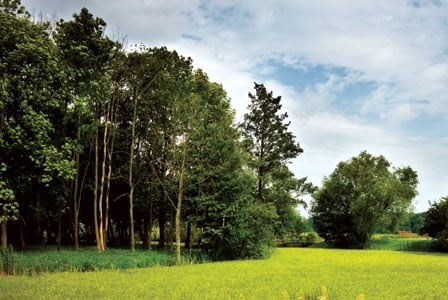
A natural burial is an eco-friendly alternative to conventional burials. Popular in England, green funerals are slowly gaining popularity in Canada too.
A natural burial is an eco-friendly alternative to conventional burials. Popular in England, green funerals are slowly gaining popularity in Canada too.
A green, or natural burial, is typically done without embalming fluid. The body is wrapped in a cloth shroud or placed in a biodegradable casket and the grave is marked with a simple fieldstone, a seedling, or in some cases, nothing at all.
Natural burial areas are usually landscaped with native grasses, wildflowers, and trees, and the grounds are less manicured than a conventional cemetery—think grassy meadow rather than golf course.
Natural burials in history
It wasn’t so long ago that green burials were the norm, not the exception, according to Mark Harris, author of Grave Matters (2007, Scribner).
“We did green burials for hundreds of years by default,” says Harris. Historically, most burials took place outside of formal cemeteries and were usually done by the family.
“It wasn’t until the early 1900s that modern burial practices became widespread in North America,” he says.
Embalming was first used to transport dead soldiers back to their families. Ornate coffins replaced pine boxes as a sign of wealth, and concrete vaults were used to keep out grave robbers. The result, believes Harris, has been an institutionalized approach to death.
“People have said [a] is a kooky environmental idea, but I think it really represents a return to a tradition that was quite sensible,” says Harris.
Breaking new ground
Green burials began more than 15 years ago in Carlisle, England, as a means of preserving the area’s dwindling green space. Since then, more than 200 cemeteries around the world have created natural burial sites. One of these is Royal Oak Burial Park in Victoria, BC, which opened Canada’s first natural burial ground in October 2008.
“We [initially] developed only one-third of an acre because we weren’t sure what the response would be,” says Stephen Olson, executive director of Royal Oak Burial Park, “but the response has been quite significant.”
Since opening, there have been two to three green burials a month, and plans are underway to expand the natural burial area, Woodlands, to an acre.
“There is a portion of the population for whom this type of burial is very appealing,” says Olson. “For people who have lived as environmentally sensitive as they can, this is what they’ve been waiting for as the final act of their life.”
What lies beneath
While most cemeteries look manicured and green, what lies below the surface tells a different story. According to the Centre for Natural Burials, a typical “ten-acre swatch of cemetery ground contains enough coffin wood to construct more than 40 homes, nearly a thousand tons of casket steel and another twenty-thousand tons of concrete for vaults.”
Formaldehyde, the primary ingredient in embalming fluids, is another concern. We bury more than 3 million litres of embalming fluid every year in North America, some of which eventually leaches into surrounding soil and groundwater.
Even cremation, long considered the most environmentally friendly option, has its eco-drawbacks. It takes large quantities of natural gas to cremate a body, and the combustion process gives off a host of toxins to the atmosphere.
Joining the cycle of life
While green burials have big environmental benefits, there’s more to them than that, says Mike Salisbury, president of the Natural Burial Cooperative. “There’s a sense of completing the natural cycle,” says Salisbury.
“I think people are dissatisfied with the consumption involved in a conventional burial,” he says, noting that natural burials have little in the way of wastage or excess. “They may not be hard-core environmentalists, but they see a sense of value in the green burial.”
For many, green burials are an easy choice. They cost less, and they work with the natural processes that sustain us and those that come after us. What’s not to like about that? Eternal eco footprint
Planning a funeral—whether our own or a loved one’s—can be a difficult task emotionally, financially, and environmentally. While some people opt for conventional burial, over 68 percent of Canadians chose to be cremated in 2009 compared to almost 37 percent of Americans.
What are the environmental impacts of a conventional funeral?
Conventional burial
- many embalming fluids contain formaldehyde, a carcinogen; funeral embalmers have a higher incidence of myeloid leukemia as a result of their exposure to formaldehyde
- 1.6 tons of reinforced concrete are used to build vaults for caskets in the US, a process which uses large amounts of energy for manufacture and transportation
- 130 to 150 board ft of lumber go into making a typical hardwood casket
- the impact of remains on groundwater is not understood
- herbicides used for lawn care at cemeteries contaminate the soil
Cremation
- the process requires the burning of fossil fuels
- gaseous emissions are released into the air that contain toxins such as carbon dioxide and mercury (often from dental fillings)
- ashes (or cremains) may contain a variety of metals including lead, copper, tin, magnesium, manganese, nickel, and strontium
- the environmental impact of scattering ashes or burying ashes is not known
Eco-burials in Canada
Green burials are far more common in the UK than in North America. There are approximately 220 natural burial sites in the UK and approximately 15 in the US. These Canadian cemeteries have green burial options:
- Royal Oak Burial Park, Victoria, BC, robp.ca
- Cobourg Union Cemetery, Cobourg, Ontario, ecoburials.ca
Planning an eco-burial
If your local cemetery offers green burials, your first step should be a visit to the grounds. Ask the following questions:
- Does the cemetery require the body to be embalmed?
- Do they offer a conservation easement to protect the land in perpetuity?
- Do they use pesticides, herbicides, or fertilizers on the grounds?
- Is there a marker placed on the grave?
- Is there a local casket supplier that can provide a biodegradable option?



